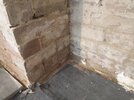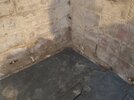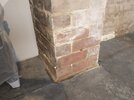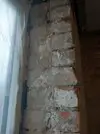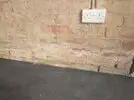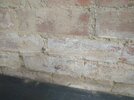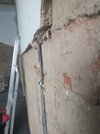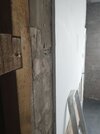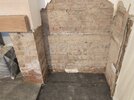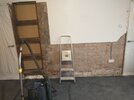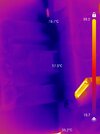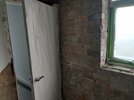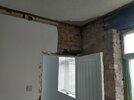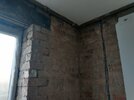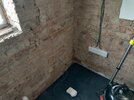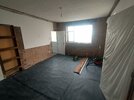Hi,
I've spoken with some manufacturers of various damp proofing products and I plan on tackling some damp walls with the following setup; I am getting conflicting advice so I am not sure if this is the done thing - I've had everything from just use lime, to sand and cement to membrane to renovating plaster to tanking slurry.
The room in question is a ground-floor dinning room that has had some historical damp that infected the lime plaster with salts, and some more recent damp which is either due to a concrete sub-floor bridging the original DPC or due to some gypsum / bonding plaster bridging against the concrete floor.These have been fixed (plaster removed around bottom 1 meter of room, exterior re-pointed in lime, dryrods installed along mortar line as close to floor as possible, floor / wall edging cleaned up).
Room details:
* Gable end wall = 13" solid brick + lime mortar
* Interior walls = 4"/9" solid brick + lime mortar, some timber framing (historically had plasterboard, removed as part of clean up)
* Interior wall finish = 1 meter and above; lime plaster -> lime finish coat -> gypsum skim (all in very good condition, no moisture / salt content detected.)
* Total wall area to cover = 25/30m2
* Floor = concrete on soil with bitumen layer underneath
I am now left with walls that, for the most part, are bone dry and a few patches are drying out, mainly around the chimney and an alcove that is on a party wall, salt bands are appearing on the walls that are drying out with damp, except the penetrating damp, being no more than 2 bricks high.
I had planned on doing the following, which was agreed by a manufacturer as being acceptable practice, please let me know if this is wrong, and if so what is the proper solution.
1. Clean wall surfaces, including removing old lime / gypsum and embedded wood fixings.
2. Salt neutraliser agent on all exposed masonry, and allow to thoroughly dry.
3. Liquid DPM (water-based (SBR type?)) (two coats) on exposed masonry.
4. Plasterboard with foam adhesive or acrylic adhesive.
a. Insulated plasterboard on gable end wall.
b. Normal plasterboard for all internal walls.
5. Gypsum skim.
My backup plan is to use the Dryzone Express system, however as I understand it, it's really just the same as above except there is no liquid DPM, which concerns me as I am just relying on a thin barrier to stop any future moisture / salt infection in the new plasterboard surfaces.
I am trying to avoid renovating plasters and lime plaster as they too expensive and not very DIY friendly.
I've spoken with some manufacturers of various damp proofing products and I plan on tackling some damp walls with the following setup; I am getting conflicting advice so I am not sure if this is the done thing - I've had everything from just use lime, to sand and cement to membrane to renovating plaster to tanking slurry.
The room in question is a ground-floor dinning room that has had some historical damp that infected the lime plaster with salts, and some more recent damp which is either due to a concrete sub-floor bridging the original DPC or due to some gypsum / bonding plaster bridging against the concrete floor.These have been fixed (plaster removed around bottom 1 meter of room, exterior re-pointed in lime, dryrods installed along mortar line as close to floor as possible, floor / wall edging cleaned up).
Room details:
* Gable end wall = 13" solid brick + lime mortar
* Interior walls = 4"/9" solid brick + lime mortar, some timber framing (historically had plasterboard, removed as part of clean up)
* Interior wall finish = 1 meter and above; lime plaster -> lime finish coat -> gypsum skim (all in very good condition, no moisture / salt content detected.)
* Total wall area to cover = 25/30m2
* Floor = concrete on soil with bitumen layer underneath
I am now left with walls that, for the most part, are bone dry and a few patches are drying out, mainly around the chimney and an alcove that is on a party wall, salt bands are appearing on the walls that are drying out with damp, except the penetrating damp, being no more than 2 bricks high.
I had planned on doing the following, which was agreed by a manufacturer as being acceptable practice, please let me know if this is wrong, and if so what is the proper solution.
1. Clean wall surfaces, including removing old lime / gypsum and embedded wood fixings.
2. Salt neutraliser agent on all exposed masonry, and allow to thoroughly dry.
3. Liquid DPM (water-based (SBR type?)) (two coats) on exposed masonry.
4. Plasterboard with foam adhesive or acrylic adhesive.
a. Insulated plasterboard on gable end wall.
b. Normal plasterboard for all internal walls.
5. Gypsum skim.
My backup plan is to use the Dryzone Express system, however as I understand it, it's really just the same as above except there is no liquid DPM, which concerns me as I am just relying on a thin barrier to stop any future moisture / salt infection in the new plasterboard surfaces.
I am trying to avoid renovating plasters and lime plaster as they too expensive and not very DIY friendly.


